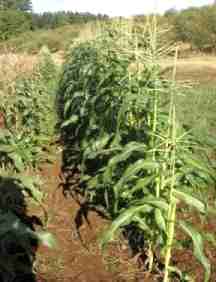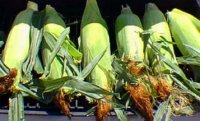|
CORN |
||||||||||||||||||||||||||||||
|
HOME BIOLOGY CREW GEOGRAPHY HISTORY INDEX MUSIC FILMS THE BOAT SOLAR BOATS SPONSORS |
||||||||||||||||||||||||||||||
|
INTRODUCTION
Corn is a truly versatile crop. Products ranging from corn on the cob and corn meal to corn oil and ethanol all start out in fields very much like ours. We grow sweet corn for eating right off the cob; however the corn maze is planted with field corn which is is bit more durable.
The Corn Laws
The Corn Laws were a series of statutes enacted between 1815 and 1846 which kept corn prices at a high level. This measure was intended to protect English farmers from cheap foreign imports of grain following the end of the Napoleonic Wars. Note: in this context "corn" means grain of all kinds, not simply the vegetable corn.
During the Napoleonic Wars, the British blockaded the European continent, hoping to isolate the Napoleonic Empire and bring economic hardship to the French. One result of this blockade was that goods within the British Isles were protected against competition from outside sources. Farming became extremely lucrative, and farming land was traded at very profitable rates. When the wars ended in 1815 the first of the Corn Laws was introduced. This law stated that no foreign corn would be allowed into Britain until domestic corn reached a price of 80 shillings per quarter.
Who Benefited? The beneficiaries of the Corn Laws were the nobility and other large landholders who owned the majority of profitable farmland. Landowners had a vested interest in seeing the Corn Laws remain in force. And since the right to vote was not universal, but rather depended on land ownership, voting members of Parliament had no interest in repealing the Corn Laws.
Who suffered? The artificially high corn prices encouraged by the Corn Laws meant that the urban working class had to spend the bulk of their income on corn just to survive. Since they had no income left over for other purchases, they could not afford manufactured goods. So manufacturers suffered, and had to lay off workers. These workers had difficulty finding employment, so the economic spiral worsened for everyone involved.
The first major reform of the Corn Laws took place during the ministry of the Duke of Wellington in 1828. The price of corn was no longer fixed, but tied to a sliding scale that allowed foreign grain to be imported freely when domestic grain sold at 73 shillings per quarter or above, and at increasing tariffs the further the domestic price dropped below 73 shillings. The effect of this reform was negligible.
In 1832 the right to vote was extended to a sizable portion of the merchant class through the passage of The Reform Act. The merchant classes were far more likely to look favorably on changes to the Corn Laws.
The Reformers. Several groups arose during the early and mid 1800s to fight for repeal of the Corn Laws amid other social reforms. Most prominent among these movements were the Chartists and the Anti-Corn Law League. The ACLL began in 1836 as the Anti Corn Law Association, and in 1839 adopted its more familiar name. Despite its social reform agenda, the league drew its members largely from the middle-class; merchants and manufacturers. Their aim was to loosen the restrictions on trade generally, so that they could sell more goods both at home and around the world. After constant agitation, the ACLL was successful, and in 1846 the government under Sir Robert Peel was persuaded to repeal the Corn Laws.
In American regional cooking, corn is important in many recipes, such as corn chowder, creamed corn, succotash, and cornbread. But no preparation can come close to the timeless appeal of simple buttered corn on the cob. All over the Midwest and Great Plains, small towns celebrate the harvest with sweet corn festivals. Settlers adapted the Indian style of roasting corn with the husks removed, and to this day, street vendors around the world sell husked corn.
In Iowa, the heart of the Corn Belt, almost half of all cultivated land is devoted to corn, making it first in the nation for corn production. Corn is the largest crop in the United States, in terms of acres planted and the value of the crop produced. It is also the most widely distributed crop in the world. In Native American usage, the word for corn means "our life," or "our mother," or "she who sustains us." It was the cultivation of corn that turned Native American tribes from nomadic to agrarian communities.
It was from the Native Americans that the first European settlers learned about corn. Native Americans had spent hundreds of years developing what we now know as corn from seed-bearing grass. Long before Christopher Columbus sailed from Spain in 1492, Native Americans were cultivating this grass in North, Central, and South America. Native American farmers in the Ohio River Valley had been growing corn for more than 1,700 years before the first white men crossed the Appalachian Mountains, and there is evidence that they used corn to brew beer before Europeans arrived in the Americas.
The Pawtuxet Indian tribe in Massachusetts was cultivating corn when the first settler arrived, and corn was on the first Thanksgiving table in 1621. If it had not been for corn, the Pilgrims of Plymouth Colony might have starved to death during their first year in America. The Indians taught settlers how to grown corn, pound corn into meal, and how to cook with it. The words of Governor William Bradford, first governor of the Plymouth Colony, now inscribed on a brass plaque at Truto (Corn Hill) on Cape Cod, Massachusetts, reflect the settler's gratitude: "And sure it was God's good providence that we found this corne for we know not how else we should have done."
Corn Nutrition
Serving
Size: 1 medium ear (90g)
Fully ripe sweet corn has bright green, moist husks. The silk should be stiff, dark and moist. You should be able to feel individual kernels by pressing gently against the husk. Fresh corn, if possible, should be cooked and served the day it is picked or purchased. As soon as corn is picked, its sugar begins is gradual conversion to starch, which reduces the corn's natural sweetness. Corn will lose 25% or more of its sugar within 25 hours afte harvesting it. If for some reason corn is not being used immediately or has been purchased from the supermarket, add sugar to replace that which has been lost. Add one teaspoon sugar for each quart of water. Between purchasing and cooking, keep the corn moist and cool. Pack in a cooler for the trip home from farm or market and refrigerate corn immediately after taking it home. By refrigerating the corn it helps the corn stay sweet by not letting the sugars turn to starch. Use within two or three days.
Favorite Corn Recipes:
Avocado-Corn Salsa Baked Herb Polenta Sticks Baked or Grilled Corn On The CobCorn Souffle with Creamed Onion Sauce Frogmore Stew Grilled Corn on the Cob with Lime and Chile How To Grill Corn On The Cob Iowa Corn au Gratin Sweet Corn, Mozzarella, and Tomato Salad
Solar Cola - a healthier alternative
We are looking for distributors in America, Australia, Canada, Europe, and Japan. The state of the Cola market globally and in the UK is ripe for a fresh quality brand, with excellent potential for growth. According to ResearchandMarkets.com the UK drinks market is worth an estimated £53.5 billion, representing a 7% share of total consumer spending. The global soft drinks market is roughly the same percentage of total consumer spending for developed countries.
Prospective investors in our company should consult their own independent investment advisers, and please note this information is provided for general guidance only. It is not a prospectus, but is provided in response to the number of requests we have received asking for more information
For all trade enquiries please contact: Nelson Kruschandl at:
Solar Cola UK or Solar Cola Exports The Old Steam House Herstmonceux, BN27 1RF United Kingdom
+ 44 (0) 1323 831727 +44 (0) 7905 147709
|
||||||||||||||||||||||||||||||
|
This website is Copyright © 1999 & 2006 NJK. The bird logo and name Solar Navigator and Solar Cola are trademarks. All rights reserved. All other trademarks are hereby acknowledged. Max Energy Limited is an environmental educational charity. |
||||||||||||||||||||||||||||||
|
BLUEBIRD ELECTRIC CAR MANUFACTURERS ELECTRIC CARS ELECTRIC CYCLES SOLAR CARS |


